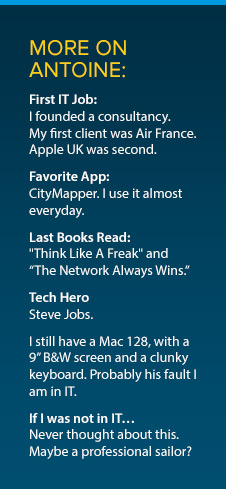
Get your FREE 30-day trial.
Please complete all fields.
For over two decades, Eurostar has carried some 150 million passengers to and from the United Kingdom, France, Belgium, and beyond, via the Channel Tunnel. The aim of the high-speed train service is to be the most loved travel experience in Europe. For CIO Antoine de Kerviler and his team, this means making every interaction each customer has with the brand “delightfully easy.” Continue reading this “IT Visionaries” to learn how de Kerviler’s broader vision supports this goal and why he says development speed is the key to making happen.
The beginning of our journey with Salesforce began with Service Cloud. Our call center had way too many tools. Agents were using 14 disparate systems. We had to do something to make their work lives easier. Now 80% of calls are answered in one application. Our agents are advocates for our brand and they love the new customized console. We had an issue for a few months because there was a group of agents who didn’t yet have Salesforce and they were very jealous.
 2. Have you been building any custom applications?
2. Have you been building any custom applications?
We’ve replaced our legacy intranet with a modern social community built on Force.com. When service disruptions occur, Eurostar’s team of 1800 employees can communicate real-time information and post photos, from any device. We are about to release an internal page where our staff can see how many passengers will travel on Eurostar that specific day, which trains are running, and what the on-time performance is. It’s a way to bring everything back for employees, so they can continually see their work in action.
We are planning 15 to 20 additional apps to replace manual processes across the Business. As a corporate benefit, staff receives discounted Eurostar tickets. Today they have to telephone the call center department to manage the process. IT is building a staff travel app where requests can be created in Salesforce. The call center can then process these requests as they have time and it will keep the phone lines open for urgent customer issues.
Most of our customers, if not all, understand service disruptions happen. What they want is for us to provide them with a solution as fast as possible. Earlier this year, we released a basic custom Salesforce form, which travelers can use to submit their rebooking preferences. High priority cases are escalated and requested refunds are issued. It was a great success inside and out of the company. We’re about to release a self-service online compensation app. In Europe, when trains run late, customers are entitled to a compensation. With this app, they will be able to quickly create cases online and receive an immediate answer with their electronic voucher, instead of having to request by mail and wait for the answer.
To make Salesforce the internal centerpiece at Eurostar for collaboration and customer knowledge. Our focus is on serving our clients, not building servers and managing infrastructure. We typically receive 800 to 2000 phone calls a week. When there is a service disruption, it’s five-times that in a matter of minutes, while our web site gets ten-times the typical amount of traffic. Our legacy platforms can’t support that volume. Salesforce App Cloud means we can change the scale of how fast we can react.
IT needs to support the business. It needs to help the company in every way possible to improve the customer experience. That is certainly one of our objectives at Eurostar. IT should never be the one slowing down the company when it comes to delivering something to our customers. Never. And we have to be able to create it in the needed time frame. It’s so important to put the right technology within reach of the company. App Cloud has enabled us to release applications in days or weeks, not months or years. We’d never be able to do that with a different solution.
.jpg)
Put yourself in your customers’ shoes, both internally and externally. When we encounter major operational disruption, IT team members put on yellow customer service jackets and go to the station to assist customers. One of them, after a day in the station, took a piece of paper and designed the customer re-booking app. When we took it to our colleagues from the station team, they said, “That’s exactly what we want.” If we had tried to develop it the traditional way, it would have taken six months to design it, going back and forth. But by doing our due diligence, Eurostar IT built a solution that understood the process and thus had actual value.
The role of technology within an organization is rapidly evolving — and so is the role of the CIO. So how can IT leaders manage this transition and take advantage of rapidly emerging opportunities? Download this e-book to meet 12 visionaries who are leading IT transformations in their organizations.